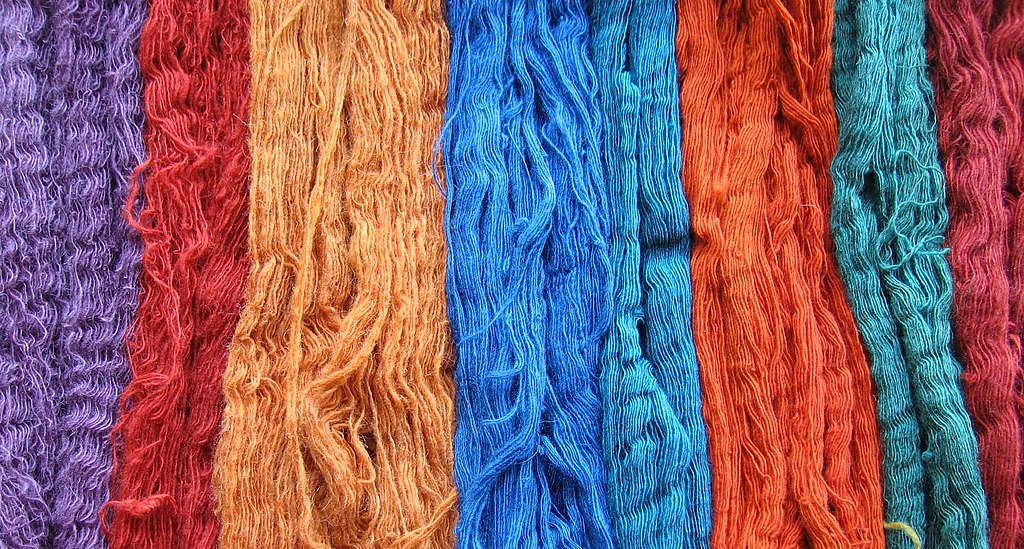Colour dyes: methods and processes

Image by Alamcsd at wts wikivoyage via Wikimedia Commons, in the public domain.
Early dye processes involved soaking and boiling textiles in coloured solutions made from substances such as roots, berries, bark, leaves, wood, fungi, and animal products in a direct or substantive dyeing method. However, these dyed textiles may not have had a very lasting colour. It was eventually discovered that different methods could be used to create stronger colours and to fix the colours so they didn’t fade or wash out so quickly.
Some methods used fermentation to create a strong colour, as with Indigo, woad and madder. For example, the indigo plant isn’t actually blue. The blue colour only comes from soaking the leaves to release the indican amino acid, which is then fermented by other plant enzymes – a process called indoxyl. It is left to dry in the air, which oxidises it, creating a blue colourant. An indigo dye bath looks green – it’s only when the dyed material is brought into the air that it oxidises and turns blue before your eyes.
Dyes like Madder can also be turned into pigments by “laking” (hence the term “madder lake”) – which means the dye is combined with a mineral salt to produce an oil-soluble substance that can be used like a paint pigment.
A mordant, which was often a type of mineral salt like sodium chloride (table salt), alum or copper vitriol, or another substance like vinegar, or even stale urine, was used to fix the dye so it wouldn’t wash out of the fabric.
Many of these processes smell terrible!
Synthetic dyes changed the complex and labour-intensive methods of natural dyeing. Many synthetic dyes are made from petrochemical processes, or from other chemicals that can be manufactured in large quantities in industrial settings like factories, and are relatively inexpensive in comparison with some natural dyes. There are many types of synthetic dyes, such as reactive dyes, disperse dyes, base and acid dyes, sulphur dyes, aniline dyes, azo dyes etc. Different types of dyes and dyeing methods suit different types of materials.
Most dyeing processes today are for textile production. The three types of fibres that are commonly used for textiles today are:
- Cellulose: cotton, flax, linen, hemp, viscose/rayon/modal (made from bamboo or other plant fibres)
- Protein: wool, mohair, silk
- Synthetic: nylon, polyester, acrylic, acetate
Here are some of the common dyes and dye techniques used in industry today:
Reactive dyeing method
Fibre-reactive dyes are commonly used for fabrics made from cotton, linen, viscose wool and silk. This type of dye “reacts” with the fibre it is colouring because of a chromophore that creates a chemical link with the fibre, binding the colour to it. The colour then becomes part of the fibre. It usually has a good level of colour fastness. Cold water dyes like Procion dyes are fibre reactive and use soda ash in the dyeing process. They do not need mordants and are non-toxic.
Disperse dyeing method
This is a high-temperature dye made from fine, insoluble dye particles that are from a suspension. They are suited to hydrophobic fibres (they don’t absorb water) such as synthetics.
Direct dyeing method
Also called Substantive dye, this method is used for cotton, and although lightfast, washes out easily. It’s called “direct” because the dye is absorbed into the fibres without help from other chemicals, such as mordants.
Vat dyeing method
Vat dyeing is still used for some textiles. Natural Indigo is one of the original vat dyeing methods, where textiles are soaked in the vat until the right colour strength is achieved. This may require more than one soaking in the vat to deepen the colour.
Basic and acid dyes
Azo dye
Azo dyes are synthetic dyes used in a variety of products, including textiles, leather, foods, cosmetics and carpets. Certain Azo dyes are considered harmful because they can break down into a carcinogenic compound called Aromatic Amines (including benzidine), and can trigger toxic effects such as allergic reactions, tumours, and endocrine disruptions. Although Azo dyes are banned in the UK and restricted in the USA, they are allowed in Australia.[1]
Learn more about the dangerous history of synthetic dyeing methods and processes from this video:
- Australian Competition and Consumer Commission(ACCC), c.2021, "Azo Dyes", Product Safety Australia, <https://www.productsafety.gov.au/products/chemicals/azo-dyes>, accessed 08/01/2023, https://www.productsafety.gov.au/products/chemicals/azo-dyes ↵

